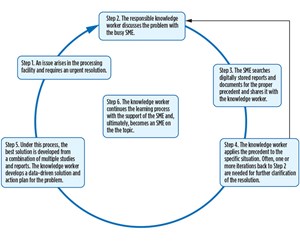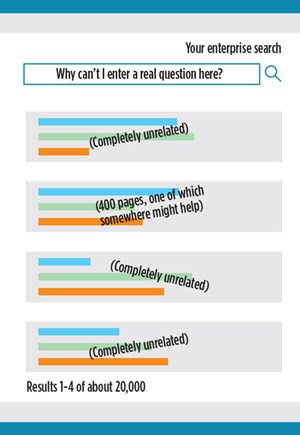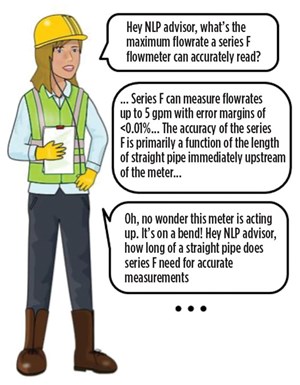Advanced data techniques streamline access to digital information
The primary goals of the oil and gas (O&G) industry are to produce more hydrocarbons, improve operational efficiency and maintain safe operations of complex equipment. To realize gains and resolve issues, O&G operators traditionally rely on the expertise of technical staff, who reference volumes of reports and studies. Unfortunately, this paradigm has become obsolete, as senior staff and subject-matter experts (SMEs) retire, and replacements fill technical positions.

Knowledge retention and transfer are common problems affecting many industries. O&G companies are vulnerable to losing valuable operational knowledge as senior staff retire. These industries must manage this big crew change and use innovative solutions to cover the knowledge gap as less-experienced staff take on key technical roles. A promising solution uses virtual advisor tools that are built on artificial intelligence (AI) algorithms, including machine learning (ML) and natural language processing (NLP). Such advanced tools have solid traction in other processing businesses and offer significant potential for the O&G industry.
BIG CREW CHANGE

Employee turnover has affected corporate balance sheets and daily operations throughout the O&G industry, Fig. 1. Due to historical hiring patterns, there is a 20-year experience gap between retiring SMEs and replacement staff.1 By 2025, millennials will constitute nearly 75% of the industry’s workforce. This new crew is already being charged to handle a larger share of technically complex and urgent issues. The next-generation staff have less experience in operations, maintenance and trouble-shooting areas. Consequently, younger engineers lean on the available SMEs for insight and knowledge, Fig. 2. With increasing requests for assistance, SMEs have less time to pursue their own high-value projects. With less background in operations, new engineers spend more time researching decisions. Such delays can have expensive repercussions, including emergency events.
RETRIEVING INFORMATION FOR DECISION-MAKING
The ideal solution to resolve the knowledge-retention problem must fit within the existing O&G workflow process. SMEs focus on summarizing results and best practices in reports and other technical documents. For process-oriented industries, unit operations, optimization and maintenance information are well-documented. A survey of 30 O&G companies indicated that over 90% of the information needed to resolve urgent issues is stored in digital historical documents.

Figure 3 illustrates the present workflow for O&G operations. New engineers rely on the expertise of SMEs to support their learning process and solve operation problems quickly and effectively. Often, the best solution is developed from a combination of multiple studies and reports. The SME can locate such information faster than the knowledge worker. The knowledge worker requires on-the-job exposure to develop subject-matter expertise.
KNOWLEDGE CAPTURE AND TRANSFER CREATE NEW WORKFLOW PROCESSES
As more experienced staff enter retirement, the workflow process must adapt. Without the aid of an SME, the knowledge worker must still identify support information from digital historical documents. Lacking experience on the subject and available resources, the knowledge worker may be unsuccessful or too slow in the search process. The proper solution exists within the digital documents; unfortunately, it is not readily accessible.
Some O&G companies have recognized opportunities to better leverage historical documents or “knowledge products.” Data-organization projects attempt to re-label and re-file each stored document for easy reference. Unfortunately, such tasks fail for four reasons:
- Incomplete solution. One relevant document rarely contains all the needed information. Too often, only part of the solution is found in one document. Other relevant sources also must be explored before making a data-driven decision and action plan. Also, finding the first document does not always help the knowledge worker understand which document should be the next to reference.
- Time. The search for the relevant documents is time-consuming. Unfortunately, less-experienced engineers spend approximately 80% of their time scouring digital documents for relevant information,2 especially when the references are text-heavy. When the knowledge worker is unfamiliar with the topic, more time and energy are used to conduct basic research. Also, key words and tables of contents are not generally helpful when searching for complex information, such as the possible causes for a particular operational problem.
- Indexing issues. Many document-organization philosophies are possible. Such methods are only good for particular inquiry categories. For example, organizing documents by subject is not helpful, when users are searching for an author.
- Poor use of resources. Many firms have hundreds of thousands of digital documents. Reviewing all possible resources is an enormous, time-consuming task. Using their background, SMEs can eventually sort through the maze of material. However, such tasks are not the best use of SMEs’ time. In one example, the data-organization project was abandoned after the SME spent 100 hr and covered < 10% of the required document sorting. The resulting project product was unfinished and useless.
ENTERPRISE-SEARCH SOFTWARE

Another approach with limited success is off-the-shelf enterprise-search software. Widely available, enterprise-search software is based on key words. The knowledge workers enter key words into a search bar and retrieve documents that include featured words. The traditional enterprise-search approach can be viewed as a turnkey solution. It does not require the same time and effort as the data-organization solution. A recent study indicated that only three of 49 representatives (approximately 6%) interviewed from 26 O&G firms were satisfied with their enterprise-search tools, Fig. 4. The interviews identified several drawbacks:
Lack of inquiry refinement. The context involves conducting research to find solutions for technical problems. For O&G issues, the simplest question is more complex than key words. A knowledge worker may be looking for common causes of a phenomenon. The enterprise search will not be able to filter results and only show those items with cause-effect relationships.
Term redundancy. In the O&G industry, many key words are redundant. Searching for a common production chemical is likely to yield a large percentage of documents unrelated to the target issue. Excess resources do not help the employee to narrow the search.
Poor understanding of industry terms and practices. Even sophisticated search engines do not fully understand the O&G industry or particular processing operations. These search engines are trained on general end-use consumer data. They do not respond well to the diverse ways in which operators organize industry knowledge.
BACK TO BASICS
If you questioned an SME with a perfect memory, who had read every available company document, you would get a very different set of answers than those generated by enterprise-search tools. Better solutions are needed to retain corporate knowledge. The newly burgeoning field of NLP offers remarkable possibilities. In several process-oriented industries, NLP-based virtual advisors are providing the equivalent SME services on information retrieval from digital documents.3,4 Building on AI developments, the NLP- and ML-based virtual advisor can answer questions in real time. Interactions with these tools mirror the pre-retirement workflow process.
NLP solutions are based on “understanding” the vocabulary and grammar that humans use. The understanding may appear different inside the algorithms. However, the reasoning effect is similar to asking a research question to an SME. A well-built NLP tool can extract the purpose of the question. With the purpose understood, the virtual advisor efficiently searches phrases and paragraphs in historical documents and returns conditions satisfying the question. Such tools create huge efficiencies in time management and identify proper resolutions to problems.
The main concern is designing the NLP tools specifically for the target industry and company use case. For the O&G industry, such endeavors are new but increasing in popularity.5 Preliminary results are quite positive. Independent and qualitative benchmarking efforts have measured the effectiveness of NLP products and compared them to other solutions applied by O&G companies.
To simulate the knowledge base used by operating companies, a community forum was referenced, in which users post technical questions about O&G topics and receive answers from a community of industry personnel. Users included operators, engineers and SMEs from around the world (Canada, China, Germany, India, Philippines, Saudi Arabia, South Korea, Taiwan, United Kingdom, and the United States). In June 2018, an NLP-based virtual advisor tool was added to the forum; users could ask questions to both the NLP-based virtual advisor and the forum. Now, the NLP-based virtual advisor searched through the forum content and crafted the relevant and accurate answers. To ensure an adequate body of knowledge resembling that from O&G company staff, nearly 6,000 user questions and answers were recorded into the forum before the comparative study began.
SMEs were shown question-and-answer pairings from the virtual advisor. According to the SMEs, the NLP-based virtual advisor could interpret and process the technical nuances of the questions and reference information in ways resembling an experienced human. From its own research, the NLP-based virtual advisor associated one industry term to another, just as would an experienced SME.
INFERRED TERMINOLOGY AND UNDERSTANDING

The NLP-based virtual advisor also was able to interpret the intent of the questions in ways that resembled a human’s interpretation, as illustrated in Fig. 5.
Upstream example. The NLP-based virtual advisor was asked, “What is the flowrate handled by a single-buoy mooring (SBM)?” The system returned an answer relevant to a specific SBM station design. In addition, the NLP-based virtual advisor returned, “The flowrate handled by SBM varies depending upon the pipeline size,” and provided an explanation of how this occurs. When viewed together, both answers indicate that SBM stations have multiple design specifications. To answer the question properly, a range must be considered or a particular SBM product must be specified. Without the NLP-based virtual advisor, a less-experienced user scouring for information may find a single value in a document and end the search. With incomplete details or misinformation, it is highly possible that incorrect steps are taken, thus creating dangerous situations.
Users of the NLP-based virtual advisor were satisfied with generated answers. When submitting a question to the NLP-based virtual advisor tool, users were given the option to post that question to the general forum. Satisfaction with the tool was measured by the likelihood that a user would post his or her question to the general forum. Of courses, users may have other reasons not to post their questions to the general forum. From the study, roughly 1 in 20 questions across all samples were posted to the forum, thus leading to a satisfaction rate of approximately 95%.
EVALUATION METRICS: TIME VS. ACCURACY
In addition, the study examined the correctness of retrieved solutions between the forum and the NLP-based virtual advisor. Success was measured by the time required to answer a question, as well as the accuracy of provided information. In this comparative study, a human averaged over 1.5 days to answer a forum question. In some cases, users reviewed previous posts, as the needed information was obscured by large quantities of irrelevant material.
In contrast, the NLP-based virtual advisor could provide answers in seconds. This drastically shortened response time may have caused the observed increase in follow-up inquiries on support information that were clearly not re-phrasings of the original questions. By getting feedback in real time, users were prompted to learn more about the subject. Such responses are similar to an informative conversation with an SME.
Besides faster response time, the NLP-based virtual advisor returned more accurate information than that supplied by the forum. For example, the median responses posted by users directly to a given question in the forum were two across all samples taken. In contrast, the median number of responses generated by the NLP-based virtual advisor from all available information was 10 across all samples taken. With multiple relevant answers to each question, the NLP-based virtual advisor exposed controversies in unresolved issues, provided complementary information to form a more complete answer, and uncovered false assumptions held by the user.
OPTIMIZING CORPORATE KNOWLEDGE
The big crew change and its aftermath require using innovative solutions to solve operating problems. O&G companies have a wealth of digitally stored knowledge. Less-experienced technical staff need innovative tools to efficiently access valuable operations and processing information. Advancements in AI, in the areas of NLP and ML, support innovative tools, such as virtual advisors already trained to understand the details of the O&G industry. Such methods can time-efficiently review digital documents and provide quality information for decision-making. With better tools, less-experienced staff gain more knowledge and are more productive. The NLP-based virtual advisor can assist technical teams across the O&G industry and provide real-time advice using company data and resources.
LITERATURE CITED
1Nussbaum, A., and D. Wethe, “Lost generation of oil workers leaves few options for next boom,” Bloomberg, July 6, 2016.
2Larsen, Å. H., Equinor CIO Keynote Address, Society of Petroleum Engineers, SPE Digital Transformation Study Group, Digital Transformation Annual Congress 2019, May 10, Houston, Texas.
3Mejia, N., “Natural language processing in Insurance: Current applications,” Emerj, Feb. 14, 2019.
4Perrons, R. K., and J. W. Jensen, “Data as an asset: What the upstream oil & gas industry can learn about ‘Big Data’ from companies like social media,” SPE paper 170633-PT, 2014.
5VB staff, “The enterprise AI conundrum: Build or buy,” VentureBeat.com, Jan. 23, 2019.
- Digital transformation/Late-life optimization: Harnessing data-driven strategies for late-life optimization (March 2024)
- The reserves replacement dilemma: Can intelligent digital technologies fill the supply gap? (March 2024)
- Digital tool kit enhances real-time decision-making to improve drilling efficiency and performance (February 2024)
- Digital transformation: Digital twins help to make the invisible, visible in Indonesia’s energy industry (January 2024)
- Digital transformation: A breakthrough year for digitalization in the offshore sector (January 2024)
- Quantum computing and subsurface prediction (January 2024)


